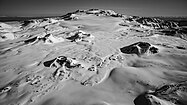Wikipedia:Main Page (2016 redesign)/Tomorrow
From tomorrow's featured article
The Mount Edziza volcanic complex (MEVC) is a group of volcanoes and associated lava flows in northwest British Columbia, Canada. Located on the Tahltan Highland, the MEVC has a broad, steep-sided lava plateau; its highest summit is 2,786 metres (9,140 feet). Its volcanoes formed over the last 7.5 million years during five cycles of magmatic activity which spanned four epochs; the most recent eruptions took place in the last 11,000 years. Current activity occurs in the form of hot springs. The MEVC has warm summers and cold, snowy winters; snow and ice remain on the highest peaks year-round. Indigenous peoples have lived adjacent to the MEVC for thousands of years. Historically, the local Tahltan people used volcanic glass from the MEVC to make tools and weaponry. Animal species such as birds, rodents, bears, sheep, goats, moose and caribou inhabit the area. A large provincial park dominates the MEVC, which can only be accessed by aircraft or by a network of footpaths. (Full article...)
In the news
- A helicopter crash near Varzaqan, Iran, kills eight people, including President Ebrahim Raisi (pictured) and Foreign Minister Hossein Amir-Abdollahian.
- In boxing, Oleksandr Usyk defeats Tyson Fury to become the first undisputed heavyweight champion in twenty-four years.
- Protests over voting rights changes break out in the French territory of New Caledonia.
- Lee Hsien Loong steps down after nearly twenty years as Prime Minister of Singapore, and is succeeded by Lawrence Wong.
Did you know

- ... that bears may be dispersers of the Japanese mountain cherry (painting pictured)?
- ... that Romani Holocaust survivor Philomena Franz wrote about her deportation to Auschwitz, internment in Ravensbrück, escape from a camp near Wittenberge, and concealment by a farmer?
- ... that a large basin on Neptune's moon Triton may have once been filled with liquid water cryolava, similar to how liquid silicates fill lava lakes on Earth?
- ... that Inman Jackson played "as though he were born with a basketball in each hand"?
- ... that Josephine Kenyon moved from recommendations of rigid scheduling to "on-demand" scheduling in editions of her book Healthy Babies Are Happy Babies?
- ... that Amie Parnes allegedly first heard about her employer, The Messenger, ceasing operations from a New York Times article?
- ... that Coffee Talk Episode 2: Hibiscus & Butterfly was released after the main creator of Coffee Talk died in March 2022?
- ... that baritone Liviu Holender chose lieder by five composers whose music was banned by the Nazis—Schreker, Zemlinsky, Mahler, Korngold and Schönberg—for a recital at the Oper Frankfurt?
- ... that some members of the U.S. Army Air Corps were so unimpressed by the Estoppey D-8 that one member stated that he would rather use "nails and a wire"?
On this day (May 23)
May 23: Aromanian National Day
- 1568 – The Dutch Revolt broke out when rebels led by Louis of Nassau (pictured) invaded Friesland at the Battle of Heiligerlee.
- 1873 – The North-West Mounted Police, the forerunner of the Royal Canadian Mounted Police, was established to bring law and order to and assert Canadian sovereignty over the Northwest Territories.
- 1934 – During a strike against the Electric Auto-Lite company in Toledo, a fight began between nearly 10,000 American strikers and sheriff's deputies, later involving the Ohio National Guard.
- 1999 – Professional wrestler Owen Hart died immediately before a World Wrestling Federation match after dropping 70 feet (21 m) onto the ring during a botched entrance.
- 2008 – The International Court of Justice awarded the Middle Rocks to Malaysia and Pedra Branca to Singapore, resolving a 29-year-old territorial dispute in the Singapore Strait.
- Ignaz Moscheles (b. 1794)
- Franz Xaver von Baader (d. 1841)
- David Lewis (d. 1981)
- Luis Posada Carriles (d. 2018)
Be an editor
Anyone can edit Wikipedia! Click the Edit tab at the top of most pages (or the [edit] link above sections) to correct errors or fix red links. If you want to take on other tasks, our introduction will guide you through the basic principles of editing.
There are many resources to help you along the way:
- Help desk – for help on editing
- Reference desk – to help you find information on any subject
- Teahouse – a help desk aimed at new editors
- Village pump – to discuss Wikipedia itself with other editors
- Community portal – for even more resources
Tomorrow's featured picture

|
|
InSight was an American spacecraft mission launched by NASA and the Jet Propulsion Laboratory, consisting of a robotic lander designed to study the deep interior of the planet Mars. Launched in 2018, the mission was active until late 2022, when contact with the lander was lost. InSight's objectives were to place a seismometer on the surface of Mars to measure seismic activity and provide accurate three-dimensional models of the planet's interior, and to measure internal heat transfer using a heat probe to study Mars's early geological evolution. This was intended to provide a new understanding of how the Solar System's terrestrial planets (Mercury, Venus, Earth and Mars) as well as the Moon formed and evolved. This 2015 photograph shows three technicians working on the InSight lander with its solar panels deployed during preflight testing in a cleanroom in Denver, Colorado. Photograph credit: NASA / JPL-Caltech / Lockheed Martin
Recently featured:
|
Wikipedia languages
This Wikipedia is written in English. Many other Wikipedias are available; some of the largest are listed below.
-
1,000,000+ articles
-
250,000+ articles
-
50,000+ articles
Sister projects
Wikipedia is written by volunteer editors and hosted by the Wikimedia Foundation, a non-profit organization that also hosts a range of other volunteer projects:
-
Commons
Free media repository -
MediaWiki
Wiki software development -
Meta-Wiki
Wikimedia project coordination -
Wikibooks
Free textbooks and manuals -
Wikidata
Free knowledge base -
Wikinews
Free-content news -
Wikiquote
Collection of quotations -
Wikisource
Free-content library -
Wikispecies
Directory of species -
Wikiversity
Free learning tools -
Wikivoyage
Free travel guide -
Wiktionary
Dictionary and thesaurus



